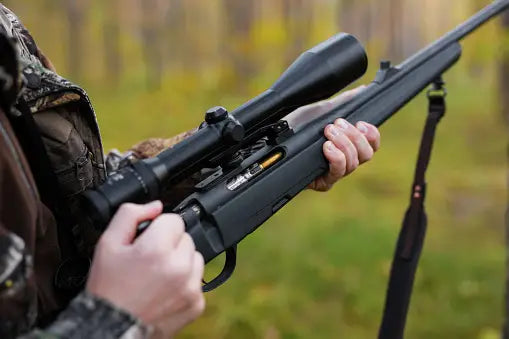Properly mounting a scope is essential for ensuring accuracy and longevity of both the scope and the firearm. Following these steps will help ensure a secure, properly aligned, and functional mounting.
Preparation
Before beginning the installation process, gather all the necessary tools and ensure the mounting surfaces are clean and free from any debris or oil that could interfere with proper installation.
Clean all mounting surfaces
Ensure that both the receiver and scope ring mounting points are free of dirt, oil, or rust. This will ensure a proper fit and prevent any misalignment or slippage.
Gather necessary tools
- Torque Wrench: Ensures screws are tightened to the correct specifications, preventing over-tightening or under-tightening.
- Level: Used to ensure the scope is properly aligned horizontally.
- Mounting Rings: Secure the scope to the bases. Choose rings that match the diameter of the scope tube.
- Bases: These attach to the firearm's receiver and provide the foundation for mounting the rings and scope.
- Thread-locking Compound: Used to prevent screws from loosening over time due to recoil and vibration.
Installation Steps
Step 1: Install Base Mounts to the Receiver
- Begin by securely attaching the base mounts to the firearm's receiver. Use the appropriate screws and ensure they are tightened to the manufacturer's recommended torque specification.
- Tip: Make sure the base is positioned correctly according to the design of your rifle and scope. Some bases are specific to certain rifle models or action types.
Step 2: Attach Scope Rings to the Base
- Place the scope rings on the base mount. Be sure to position them evenly and at the correct spacing to allow the scope to sit properly once installed.
- Loosely tighten the screws on the ring mounts to hold them in place temporarily, but don't fully tighten them yet.
Step 3: Place Scope in Rings without Fully Tightening
- Carefully place the scope into the rings, ensuring it is seated properly.
- The scope should sit snugly but not be under excessive pressure. At this point, you should not fully tighten the screws.
Step 4: Ensure Proper Eye Relief (3-4 inches)
- Adjust the scope's position in the rings to achieve the proper **eye relief**, which is typically between 3 to 4 inches from the ocular lens to your eye. The right eye relief ensures you get a full, clear view through the scope and helps avoid injury if the rifle recoils.
- Tip: Test eye relief by mounting the rifle and looking through the scope to check for a full field of view. Adjust the position of the scope as needed.
Step 5: Level the Scope Using Reference Points
- Use a level to ensure the scope is perfectly horizontal. You can place the level on the scope's turret or use a level on the receiver or base for a reliable reference.
- Ensure that the reticle (crosshairs) is also aligned in the vertical plane to avoid canting, which could affect accuracy.
- Tip: Check for proper scope alignment from multiple angles to ensure it is properly leveled and oriented.
Step 6: Torque Ring Screws to Manufacturer Specifications
- Once the scope is in position, tighten the ring screws gradually, alternating between the screws to ensure even pressure is applied to the scope. This prevents misalignment or scope distortion.
- Use a torque wrench to tighten the screws to the manufacturer’s recommended torque specification. Over-tightening can damage the scope or base, while under-tightening may lead to a loose fit.
Step 7: Double-check All Alignments
- After tightening the ring screws, double-check everything: the scope alignment, the eye relief, and the scope level. It’s also important to verify that the scope is not in contact with the rifle’s stock or other parts that might interfere with its operation.
- Tip: Make sure the windage and elevation turrets are in their neutral positions before mounting. This will ensure the scope is centered and won't require extensive adjustments after installation.
Post-Installation Checks
- Check for Clearance: Ensure that the scope has proper clearance and won't interfere with any part of the rifle during recoil. Ensure that the rifle's bolt can be cycled freely without contacting the scope.
- Recheck Torque: After a test fire, recheck the torque on all screws. Recoil can loosen screws, especially if thread-locking compound was not used.
- Perform a Zeroing Procedure: After the scope is mounted and all screws are secure, it's time to zero the rifle at the desired distance. Make sure the adjustments for windage and elevation are working as intended.
By following these steps and paying attention to detail, you will ensure a secure, accurate, and reliable mounting setup for your scope.
Maintenance and Care
1. Regular Maintenance
- Keep Lenses Clean
Regularly clean the lenses of your scope using a soft, lint-free cloth or lens cleaning solution designed for optics. Avoid using rough materials that may scratch the surface. For tougher dirt or fingerprints, use a lens cleaning brush or a gentle air blower before wiping the lens.
- Check Mount Tightness
Ensure the scope is securely mounted on your firearm or equipment. Periodically check the tightness of the screws or mounting rings to avoid any potential shifting during use. A loose mount can affect your shot accuracy, so always verify tightness before heading out for a session.
- Protect from Moisture
Moisture is one of the biggest enemies of optics. While many modern scopes are fog- and water-resistant, it is still important to take precautions. Avoid storing your scope in humid environments, and always store it in a protective case when not in use. Additionally, consider using silica gel packs in your storage case to help absorb moisture.
- Store Properly
When not in use, store your scope in a dry, temperature-controlled area. If possible, keep it in a padded case to protect it from physical damage. Avoid placing the scope under direct sunlight for extended periods to prevent damage to the lenses or internal components.
2. Periodic Checks
- Verify Zero Retention
After prolonged use or when making adjustments, always verify that the scope’s zero is retained. This can be done by firing a few test shots to confirm that the point of impact corresponds with the point of aim. If the zero has shifted, recalibrate the scope accordingly.
- Inspect Seals
The seals on your scope protect it from dust, dirt, and moisture. Over time, seals can degrade or wear out. Regularly inspect these seals for any signs of damage, such as cracks or wear marks. If you notice any issues, it may be time to replace the seals or have the scope professionally serviced.
- Check Turret Function
The turrets are used for adjusting windage and elevation. Periodically check that these turrets function smoothly and consistently. Make sure they click positively and do not feel loose or stuck. If any resistance or irregularity is noticed, it may indicate the need for lubrication or servicing.
- Confirm Reticle Clarity
Ensure that the reticle remains clear and free from obstructions. Over time, dust or debris may accumulate inside the scope or on the lens surfaces, causing blurriness or reduced contrast. Clean the lenses as necessary, and if you notice any internal fogging or damage to the reticle, consider sending the scope to a professional for repair or cleaning.
By performing these routine maintenance and periodic checks, you can ensure that your scope continues to perform optimally and lasts for many years. Regular care will help preserve the integrity of your optics and enhance your overall shooting experience.







